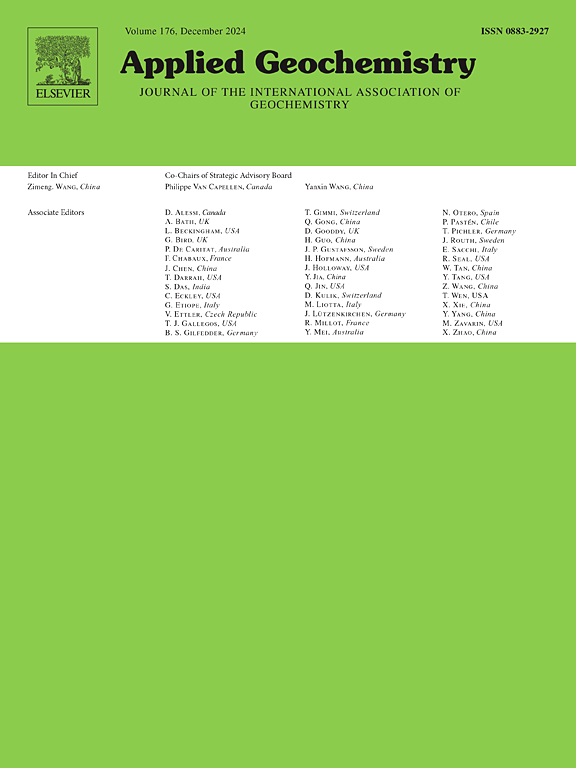Effect of sediment composition and accumulation on pharmaceutical product spatial distributions at the suburban pond scale (Beulie pond, SNO Observil, France)
IF 3.4
3区 地球科学
Q1 GEOCHEMISTRY & GEOPHYSICS
引用次数: 0
Abstract
Pharmaceutical products (PPs) are found in several compartments of the environment, and are mostly emitted by wastewater treatment plants effluents. Their occurrence in the particulate phase, in opposition with the dissolved one, also promotes their occurrence in retention areas, where particles transported by streams settle. The study focuses on understanding how different constituents of pond sediment are distributed within a suburban pond, revealing patterns or hotspots of PPs accumulation. Results confirmed the heterogeneous spatial distributions of the granulometric fractions, total organic carbon, quantitative palynofacies, crystalline phase distributions and PPs contents. The delta preferentially concentrates total organic carbon (14.5 ± 2.2 %), and particularly terrigenous organic matter and neutral PPs, while the main decantation area accumulates mostly fine particles (58.2 ± 7.7 %), kaolinite, algal organic matter and cationic PPs. The potential role played by OM and kaolinite in PPs adsorption is supported by their respective spatial trends at the pond scale. Further attention should be paid to surface sediments components and PPs sensitivity to seasonal variations, especially in terms of flow, pH and oxygenation of the water-column. This spatial approach allowed to identify preferential accumulation and concentration areas within the pond, where the following extensive characterization of interface sediments highlighted the factor likely to influence PPs trapping within the pond.

近郊池塘尺度下沉积物组成和积累对医药产品空间分布的影响(法国SNO天文台Beulie pond)
制药产品(PPs)存在于环境的几个隔间中,主要由废水处理厂的废水排放。它们在颗粒相的出现,与溶解相相反,也促进了它们在滞留区的出现,在这里,由水流输送的颗粒沉淀下来。该研究的重点是了解郊区池塘沉积物的不同成分如何分布,揭示PPs积累的模式或热点。结果证实了颗粒组分、总有机碳、定量孢粉相、晶相分布和PPs含量的空间分布均呈非均匀性。三角洲优先富集总有机碳(14.5±2.2%),以陆源有机质和中性PPs为主,而主要富集区以细颗粒(58.2%±7.7%)、高岭石、藻类有机质和阳离子PPs为主。在池塘尺度上,OM和高岭石各自的空间趋势支持了它们在PPs吸附中的潜在作用。应进一步注意地表沉积物成分和PPs对季节变化的敏感性,特别是在水柱的流量、pH值和氧合方面。这种空间方法可以确定池内优先积聚和集中的区域,下面对界面沉积物的广泛表征突出了可能影响池内PPs捕获的因素。
本文章由计算机程序翻译,如有差异,请以英文原文为准。
求助全文
约1分钟内获得全文
求助全文
来源期刊

Applied Geochemistry
地学-地球化学与地球物理
CiteScore
6.10
自引率
8.80%
发文量
272
审稿时长
65 days
期刊介绍:
Applied Geochemistry is an international journal devoted to publication of original research papers, rapid research communications and selected review papers in geochemistry and urban geochemistry which have some practical application to an aspect of human endeavour, such as the preservation of the environment, health, waste disposal and the search for resources. Papers on applications of inorganic, organic and isotope geochemistry and geochemical processes are therefore welcome provided they meet the main criterion. Spatial and temporal monitoring case studies are only of interest to our international readership if they present new ideas of broad application.
Topics covered include: (1) Environmental geochemistry (including natural and anthropogenic aspects, and protection and remediation strategies); (2) Hydrogeochemistry (surface and groundwater); (3) Medical (urban) geochemistry; (4) The search for energy resources (in particular unconventional oil and gas or emerging metal resources); (5) Energy exploitation (in particular geothermal energy and CCS); (6) Upgrading of energy and mineral resources where there is a direct geochemical application; and (7) Waste disposal, including nuclear waste disposal.
 求助内容:
求助内容: 应助结果提醒方式:
应助结果提醒方式:


